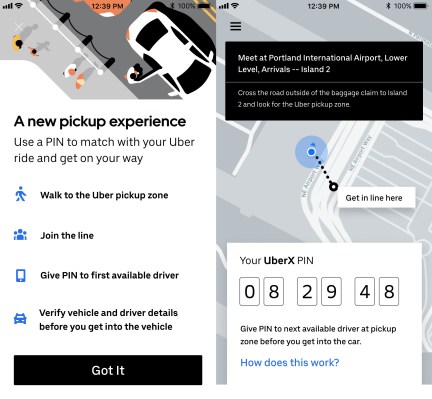Uber is piloting a new PIN feature at the Portland International Airport that will give riders a one-time six-digit numeric code in an effort to speed up pickup times and reduce traffic congestion.
The PIN, or personal identification number, feature kicks off Monday at the Portland Airport, which can average around 400 Uber rides an hour at peak time. Lyft rolled out a similar feature at the Portland Airport on Monday. Lyft’s feature uses a four-digit code.
Uber initially developed the PIN-matching solution in 2016 to serve high-volume, high-density event venues — situations that require moving potentially thousands of people in a constrained area. It’s been used at more than 60 events globally since then, including the Kentucky Derby and a Formula 1 race in Australia, according to Uber.
Uber saw an opportunity to apply the feature at airports as traffic congestion and demand for app-based rides at these locations grew. The company’s Seattle-based airports team adapted the feature and tested it at the Bangalore airport in India. Portland is the first U.S. airport to participate in the pilot.
How it works
Once riders order their UberX, they make their way to the dedicated pickup zone. The app will briefly give riders information on how the PIN feature works. A six-digit personal identification number is then assigned to the rider, who is instructed to provide it to the first available driver.
Meanwhile, the driver, who has received a pickup opportunity at the airport, heads to the pickup location and will get in a queue, waiting for the next available rider. (Drivers will be allowed to accept or snooze if they’re busy. Four minutes is the snooze duration time.)
The rider PIN is given to the driver, who types the one-time numeric code into the app. The ride commences as normal, although Uber still recommends the rider go through the standard verification checks before setting off in the vehicle.
Lyft’s code system is essentially the same. Lyft riders will be directed to a line in a designated area where Lyft drivers will be waiting via in-app instructions. The Lyft rider requests a ride and is provided a four digit code. Once passengers reaches the front of the line, they show the next driver their code. Drivers enter the code and the two will be matched. At that point, the driver can see the rider’s destination and all other rider details, according to Lyft.
What’s next
Uber’s PIN feature will likely head to other airports, if the Portland pilot is successful.
“We’ve made quite a big investment in the space,” Sondra Batbold, an Uber product manager, told TechCrunch, referring to building out Uber’s airports team. “If we zoom out and think about how much unprecedented growth airports are experiencing all over the world, it’s an important strategic partnership for us to work really closely with airports.”
In other words, Uber sees a lot of potential at airports.
That doesn’t mean Uber will offer PIN matching at every airport, Batbold said. At some locations, it will be more efficient to retain existing pickup models due to capacity constraints and curb space availability.
Article updated to include Lyft’s code-generating feature that also launched Monday at the Portland International Airport.
